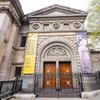More about Thomas Howard, 14th Earl of Arundel
- All
- Info
- Shop

Contributor
In his youth as an apprentice, the Flemish artist Peter Paul Rubens studied art by copying the works of other artists, and his portrait Thomas Howard, 14th Earl of Arundel shows traces of the signature style of those artists.
In the 1500's, copyright law was barely in its infancy, so students copied both written and visual works, often distributing and selling them without any ethical or legal conflict. For Rubens, and nearly all European artists, copying the signed works of other artists was a critical way of developing a discipline of artmaking and understanding the boundaries, sensibilities, and techniques of the trade. In particular, Rubens made studies of the woodcuts of Hans Holbein the Younger and the engravings of Marcantonio Raimondi, which were themselves studies of Raphael. He also saw the works of Titian and Tintoretto, which helped him discover ways to add light and life to his works.
L.V. Peck writes: "Thomas Howard, Earl of Arundel, was the most important collector in early 17th Century Britain." Here, the uncritical value judgment of "importance" is based on circular reasoning: a critic writes that the importance of the Earl as a collector derives from the prestige of the artists who produced the works in his collection, a prestige which was itself bestowed by critics. Nonetheless, something about the aura of the works of Van Dyck and Rubens, two of the major artists in the collection, is essential to understanding early 17th century Britain. For example, both artist and subject of Thomas Howard, 14th Earl of Arundel were contemporaries of John Dee, the theurgist and scientist who coined the term "British Empire." The term was meant to declare the British ambition to overtake both the "Holy Roman Empire," the birthplace of Rubens, in terms of aesthetic innovation, and the Spanish empire in military conquest.
Ironically, the Earl of Arundel was born into poverty because his family had burned their bridges with the royal family by plotting against them. He never knew his father. He married rich, and went deeply into debt by squandering the money his wife inherited on his enormous collection of art, which included several commissioned Rubens portraits.
Sources
- Belkin, Kristin Lohse. Rubens. London: Phaidon, 1998.
- Hervey, Mary Frederica Sophia. The Life, Correspondence & Collections of Thomas Howard, Earl of Arundel. Cambridge: Cambridge University Press, 1921.
- Logan, Anne-Marie S., and Michiel Plomp. Peter Paul Rubens: The Drawings. New York: Metropolitan Museum of Art, 2005.
- Loomie, Albert J. "A Lost Crucifixion by Rubens." The Burlington Magazine 138, No. 1124 (Nov. 1996).
- Peck, L.V. "Uncovering the Arundel Library at the Royal Society: changing meanings of science and the fate of the Norfolk donation." Notes and records of the Royal Society of London 52, no. 1 (1998): 3-24.
- Strauss, R.M., H. Marzo‐Ortega and V. Goulden. "Skin abnormalities in the National Portrait Gallery." Journal of the European Academy of Dermatology and Venereology 18, no. 5 (2004): 566-568.















Art and artwork is manipulated for the goals for all offers.